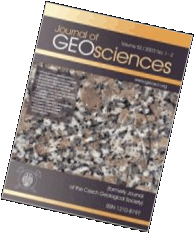 Export to Mendeley
Export to MendeleyOriginal Paper
Geochemical signature of Eocene Kuh-e Dom shoshonitic dikes in NE Ardestan, Central Iran: implications for melt evolution and tectonic setting
Journal of Geosciences, volume 57 (2012), issue 4, 241 - 264
DOI: http://doi.org/10.3190/jgeosci.126
The Late Eocene Kuh-e Dom composite intrusion forms a segment of the Urumieh-Dokhtar magmatic arc, which recorded syn- to post-collisional magmatism during the Alpine-Himalayan orogeny in central Iran. Numerous acid and intermediate-basic dikes intrude the composite intrusive complex of the arc segment and its host-rock assemblage.
The silicic dikes of porphyric microgranite, porphyric microgranodiorite and aplite consist of quartz, K-feldspar, plagioclase (albite), biotite and rare amphibole. The dikes are of subaluminous composition with shoshonitic affinity. Trace-element patterns exhibit pronounced negative anomalies of Nb, Ta, Ti, P and Sr together with positive anomalies of Cs, Th, U and La suggesting partial melting of a quartzo-feldspathic crustal source.
The intermediate-basic dikes with phonolite, basanite and trachyandesite chemical compositions typically contain pyroxene (diopside-augite) and plagioclase phenocrysts (An30-60) and An98), calcic amphiboles (magnesiohornblende-magnesiohastingsite), magnesian biotites and alkali-feldspars (Or95). The rocks show shoshonitic geochemical affinities. Low Ba/Rb ratios and high Rb/Sr ratios suggest that the primary dike melt originated by partial melting of a phlogopite-bearing lithospheric mantle, whereas LILE and LREE enrichment along with low Nb/Zr and Hf/Sm ratios and high Ba/Nb and Rb/Nb ratios imply that these rocks formed at a convergent continental margin.
The acidic dikes were emplaced in a transitional syn-collisional subduction setting whereas the intermediate-basic dikes have developed from remnant melt batches after cessation of active subduction, mostly in the post-collisional setting.
Webdesign inspired by aTeo. Hosted at the server of the Institute of Petrology and Structural Geology, Charles University, Prague.
ISSN: 1803-1943 (online), 1802-6222 (print)
email: jgeosci(at)jgeosci.org


IF (WoS, 2024): 1.3
5 YEAR IF (WoS, 2024): 1.4
Policy: Open Access
ISSN: 1802-6222
E-ISSN: 1803-1943